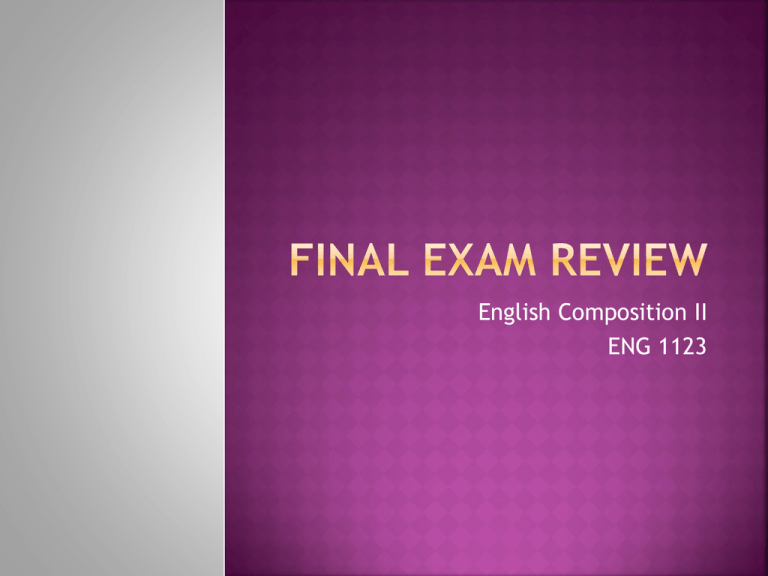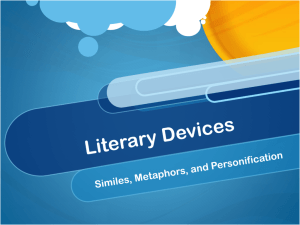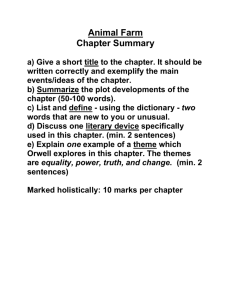
English Composition II
ENG 1123
In
works of literature, where and when the
action occurs. (89)
Where and when does the action occur?
Is the setting identifiable?
If not, what hints does the text give about
the where and when?
Are time and place consistent, or do
elements from other times or places intrude?
What is the setting in “An Upheaval” by
Anton Chekhov?
(wealthy home; 1800s Russia)
Antagonist-A
Protagonist-The
character who
opposes another.
Adversary or
opponent.
main character in
a literary work.
“The good guy”
Bogan, Brenda S., Becky T. Davis, and
Maria L. Struder. SATP2 English II .
Acworth : Enrichment Plus, LLC,
2012.Print
.
Flashback-a device in
the narrative of a
short story, novel,
etc., by which an
event or scene taking
place before the
present time in the
narrative is inserted
into the chronological
structure of the work.
http://dictionary.reference.com/bro
wse/flashback
Foreshadowing-to
show or indicate
before hand that
something is going to
happen.
http://dictionary.reference.com/bro
wse/foreshadowing?s=t
Metaphors-a figure of
speech in which a
term or phrase is
applied to something
to which it is not
literally applicable in
order to suggest a
resemblance, as in “A
mighty fortress is our
God.” (Comparing
two things without
using like or as)
http://dictionary.reference.com/bro
wse/metaphors?s=t
Similes-a figure of
speech in which two
unlike things are
explicitly compared,
as in “she is like a
rose.” Compare
metaphor.(Comparing
two things using like
or as)
http://dictionary.reference.com/bro
wse/simile?s=ts
A
type of figurative language that give
human characteristics to something nonhuman.
Example: The ocean kissed our feet as we
stood gazing at the beauty of creation.
Bogan, Brenda S., Becky T. Davis, and Maria L. Struder. SATP2 English II . Acworth :
Enrichment Plus, LLC, 2012. Print.
An
extreme exaggeration.
Example: She was so sad she could cry a
river.
I was so angry I could chew nails.
Ms. Holdiness made us write a thousand
papers.
The
fight, battle, or struggle in the story
What is the conflict in “An Upheaval”?
(A broach is stolen and Mashenka, a young
governess, is falsely accused.)
The
use of words that appeal to the senses to
give the reader a mental Picture.
Example:
The icy chill of the winter air stung my face
As the sounds of wind invade my space
Example:
The hot sun on my neck as I observe
The spikes of the crocus
The smell of the earth is good.
Bogan, Brenda S., Becky T. Davis, and Maria L. Struder. SATP2 English II . Acworth :
Enrichment Plus, LLC, 2012. Print.
Denouement-the final
resolution of the
intricacies of a plot,
as of a drama or
novel.
http://dictionary.reference.com/bro
wse/denouement
Resolution
the act of finding an
answer or solution to
a conflict, problem,
etc.
the act of resolving
something
an answer or solution
to something
http://www.merriamwebster.com/dictionary/resolution
Point
of View-the perspective of who is
telling the story.
First Person Point of View-uses the pronoun I
to make the view more personal.
Second Person Point of View-uses the
pronoun you to address the reader (informal
or persuasive)
Third Person Point of View-Uses the pronouns
he, she, it, they ect. to view a more
objective perspective. (objective, formal, or
impersonal)
Bogan, Brenda S., Becky T. Davis, and Maria L. Struder. SATP2 English II . Acworth : Enrichment
Plus, LLC, 2012. Print.
a person who gives an
account or tells the story of
events, experiences, etc.
http://dictionary.reference.com/browse/narrator
The
central message or insight into
the life revealed through the
literary work.
The team of a literary work may be
stated directly or implied. When the
them of a work is implied, readers
think about what the work suggests
about people or life.
Wiggins, Grant P., and Inc Education. Prentice Hall literature. Common Core ed.
Upper Saddle River, N.J.: Pearson/Prentice Hall, 2012. Print.
Uses
a character, place, thing, or event to
stand for something else, often an abstract
idea.
Example: a flag is a piece of cloths, but is
also represents the idea of a country.
Writers sometimes use conventional symbols
like flags. Frequently, however, they create
symbols like flags. Frequently, however they
create symbols of their own through
emphasis or repetition.
Wiggins, Grant P., and Inc Education. Prentice Hall literature. Common Core ed. Upper Saddle
River, N.J.: Pearson/Prentice Hall, 2012. Print.
A
person is saying the opposite of what it
means.
Example: A student makes an ignorant
comment in class, and the teacher says,
“You’re a genius.”
Example: Someone pulls out in front of you
and you say, “good driving.”
Wiggins, Grant P., and Inc Education. Prentice Hall literature. Common Core ed. Upper Saddle River,
N.J.: Pearson/Prentice Hall, 2012. Print.
When
the outcome is the opposite of what
you expected to happen.
Example: John is summoned into his boss’s
office. Since John has worked especially hard
this month and has broken sales records, he
is expecting a raise. When he goes into the
boss’s office, he finds that he is being fired.
Bogan, Brenda S., Becky T. Davis, and Maria L. Struder. SATP2 English II . Acworth :
Enrichment Plus, LLC, 2012. Print.
In
academic writing, the third person point
of view is usually clearer and allows a writer
to come across as more credible. Due to this
and other reasons, the third person point of
view is considered the best in academic
writing.
http://www.aims.edu/student/online-writing-lab/tools/point-of-view
The Basic Rule: You should use the past tense
when discussing historical events, and you should
use the literary present when discussing fictional
events.
1. When commenting on what a writer says, use
the present tense.
Example: Dunn begins his work with a view into
the lives and motivations of the very first settlers.
Example: Through this anecdote, Richter
illustrates common misconceptions about native
religion and shows why missionary attempts were
less than successful.
http://vanderbilt.edu/writing/manage/wpcontent/uploads/2013/06/Literary%20present%20tense.pdf
2. When describing an author’s work, however, use
the past tense.
Example: In 1966, Driss Chraïbi published La
Civilisation, ma Mère!
3. When you are writing about a certain historical
event (even the creation of a literary or artistic
work), use the past tense.
Examples:
Henry Fielding wrote in the eighteenth century.
Picasso produced a series of sculptures.
4. When discussing events in a book or story, always
use the present tense, unless there is a shift in the
timeframe within the world of the text.
http://vanderbilt.edu/writing/manage/wpcontent/uploads/2013/06/Literary%20present%20tense.pdf
5.
Sometimes a sentence must employ both
present and past tense.
Examples:
The first part of the poem, which she
completed in 1804, describes the effects of
isolation from society.
Aeschylus' drama is concerned with what
happens to Orestes after he has killed his
mother.
http://vanderbilt.edu/writing/manage/wpcontent/uploads/2013/06/Literary%20present%20tense.pdf
Normally, most words in a title are capitalized. The most
common rule is that all "important" words should be
capitalized.
In actual practice, MLA requires the first and last word in
the title is capitalized, along with every noun and every
verb, every adjective, and every adverb.
MLA typically does not capitalize prepositions and articles.
Examples:
The Planet of the Apes [The words "of" and "the" are not
capitalized.]
The Land that Time Forgot
"Why Not Me?" [Since title is so short, all the words are
capitalized.]
"Losing My Religion" [Since title is so short, all the words
are capitalized.]
http://web.cn.edu/kwheeler/documents/punctuating_titles_chart.pdf
A
comparison that is used to demonstrate a
point but which is invalid (i.e., the issues
being compared are not properly
comparable).
Example:
"Employees are like nails. Just as nails must
be hit in the head in order to make them
work, so must employees."
homepages.wmich.edu
Drawing
a conclusion based on a small
sample size, rather than looking at statistics
that are much more in line with the typical
or average situation.
Example: My father smoked four packs of
cigarettes a day since age fourteen and lived
until age sixty-nine; Therefore, smoking
really can’t be that bad for you.
Example: My friend smoked marijuana every
day for twenty years, and he has no health
issues.
http://www.logicallyfallacious.com/index.php/logical-fallacies/101-hasty-generalization
An either/or fallacy occurs when a speaker makes a
claim (usually a premise in an otherwise valid deductive
argument) that presents an artificial range of
choices. For instance, he may suggest that there are
only two choices possible, when three or more really
exist. Those who use an either/or fallacy try to force
their audience to accept a conclusion by presenting
only two possible options, one of which is clearly more
desirable.
These tactics are purposefully designed to seduce those
who are not well informed on a given topic. A clever
writer or speaker may use the either/or fallacy to make
his idea look better when compared to an even worse
one. This type of selective contrast is also a form of
stacking the deck. This type of argument violates the
principles of civil discourse: arguments should enlighten
people, making them more knowledgeable and more
capable of acting intelligently and independently.
http://ksumail.kennesaw.edu/~shagin/logfal-pbc-eitheror.htm
In
or of the form of an argument in which
one event is asserted to be the cause of a
later event simply by virtue of having
happened earlier.
http://www.thefreedictionary.com/post+hoc
ad hominem
Ad
hominem (Latin) means “against the
man”. As the name suggests, it is a
literary term that involves commenting on
or against an opponent to undermine him
instead of his arguments.
There are cases where consciously or
unconsciously people start to question the
opponent or his personal association
rather than evaluating the soundness and
validity of the argument that he presents.
These types of arguments are usually
mistaken for personal insults but they are
somehow different in nature and the
distinction is very subtle.
http://literarydevices.net/ad-hominem/
ad hominem continued
Arguers who are not familiar with the principles
of making logical arguments commonly end up
saying something that would draw the audience’s
attention to the distasteful characteristics of the
individual. Such people use this fallacy as a tool
to deceive their audience. Making such a blatant
personal comment against somebody makes it
hard for people to believe it isn’t true. Typically,
even the arguer himself believes that such
personal traits or circumstances are not enough
to dispose of an individual’s opinion or
argument. However, if looked at rationally, such
arguments even if true never provide a valid
reason to disregard someone’s criticism.
http://literarydevices.net/ad-hominem/
ad hominem continued
Example
He’s not a great athlete; he’s a fraud, a
cheat and a liar. That’s why not everybody is
“happy for Lance.”
The reasons given by the arguer may very
well be true but he does not support his
argument with reason and logic. He rather
takes the disregarding approach. He does not
say anything to prove that the premises it
proposes are problematic, instead he goes on
attacking the person who proposed them.
http://literarydevices.net/ad-hominem/
Appeals
to the readers’ intellect
Logos refers to evidence that is rational and
relevant; it appeals to the readers by
engaging their logical powers. Academic
writing relies heavily on reasoned support
and concrete evidence (facts, statistics,
examples) for its persuasive power.
Visual can also provide concrete evidence.
This evidence may be displayed in a graph,
chart, or map…
Page 76 see Figure 11.2
Howard, Rebecca Moore. Writing matters: a handbook for writing and research. Second ed.:
Print.
Appeals
to the readers by establishing your
credibility.
Establishes a credible ethos-good character,
sound knowledge or good reputationencourages readers to have confidence in
what you say.
Page 76 see example
Howard, Rebecca Moore. Writing matters: a handbook for writing and
research. Second ed.: Print.
Appeals
to your readers’ emotions
Using pathos to support a claim means
stirring the audience’s emotions in an effort
to elicit sympathy and, thus, agreement.
Pathos often relies on examples, stories, or
anecdotes to persuade readers. It also uses a
tome that stimulates readers’ feelings.
Visuals that appeal to the reader’ emotions
or believes make an emotional (or pathetic)
appeal.
Page 77 Figure 11.3
Howard, Rebecca Moore. Writing matters: a handbook for writing and research.
Second ed.: Print.
Supportive
If the audience
already trusts
your credibility
and agrees with
your position,
this could work to
your advantage.
Ex. A pro--life
speaker
presenting at a
pro-life rally. This
audience will be
supportive.
learning.hccs.edu
Wavering
The wavering
audience may be
interested in the
argument, but
don't necessarily
believe the
writer/speaker.
They may not be
as informed on
the subject as
they should be.
Hostile
An apathetic,
skeptical or
hostile audience
is obviously the
most difficult to
convince.
Ex: A republican
candidate
speaking to an
audience of
democratic
voters. This
audience will be
harder to
convince.
Deductive
Inductive
reasoning from the
general to the
particular (or from
cause to effect)
reasoning from
detailed facts to
general principles
http://www.thefreedictionary.com/dedu
ctive/inductive+reasoning
Informal
Formal
Page 24
Comp book
Page 24-25
Comp book
Sentence
Topic
Page 24
Comp book
Page 24
Comp book
Thesis
This is the central point of your paper.
Draft a one or two sentence thesis statement
that grows out of your research questions and
answers. Revise you thesis as you draft you
project. Page 135
Howard, Rebecca Moore. Writing matters: a handbook for writing and research. Second ed.: Print.
Introduction
Conclusion
Page 35-36
Page
35-36
Works
Cited or documentation
Give the information about the sources you
have cited in your paper. Page 164
Howard, Rebecca Moore. Writing matters: a handbook for writing and research. Second ed.: Print.
Presentation
of another person’s work-a
paper or story, a photograph or graphic, a
speech or song, a web page or email
message-without indication that it came
from a source. Buying a paper or “borrowing’
a sentence (without citation and quotation
marks) are both classified as plagiarism.
Page 124-135
Sources
any thing or place
from which something
comes, arises, or is
obtained; origin:
Which foods are
sources of calcium?
Evidence
that which tends to
prove or disprove
something; ground for
belief; proof.
http://dictionary.reference.com/bro
wse/source
http://dictionary.reference.com/bro
wse/evidence?s=t
Quotation
something that is
quoted; a passage
quoted from a book,
speech, etc.
Paraphrases
a restatement of a text
or passage giving the
meaning in another
form, as for clearness;
rewording.
http://dictionary.reference.com/bro
wse/quotation?s=ts
http://dictionary.reference.com/bro
wse/paraphrase?s=t
When
the text you are quoting takes up more
than four lines of your project, indent the
borrowed material as a block by one inch
from the left margin, and place the
parenthetical note one space after the
closing punctuation mark. No quotation
marks should be used when indenting quoted
material as a block. Page 153
An
ellipsis is a deliberate omission of a
portion of a quotation. The word ellipsis
(plural: ellipses)also refers to the
punctuation used to mark an omission: set of
three periods-or ellipsis points-with a space
between each. Page 450-451
A bibliography is a list of sources (books,
journals, Web sites, periodicals, etc.) one has
used for researching a topic. Bibliographies are
sometimes called "References" or "Works Cited"
depending on the style format you are using. A
bibliography usually just includes the
bibliographic information (i.e., the author, title,
publisher, etc.).
An annotation is a summary and/or evaluation.
Therefore, an annotated bibliography includes a
summary and/or evaluation of each of the
sources. Depending on your project or the
assignment, your annotations may do one or
more of the following.
https://owl.english.purdue.edu/owl/resource/614/01/










